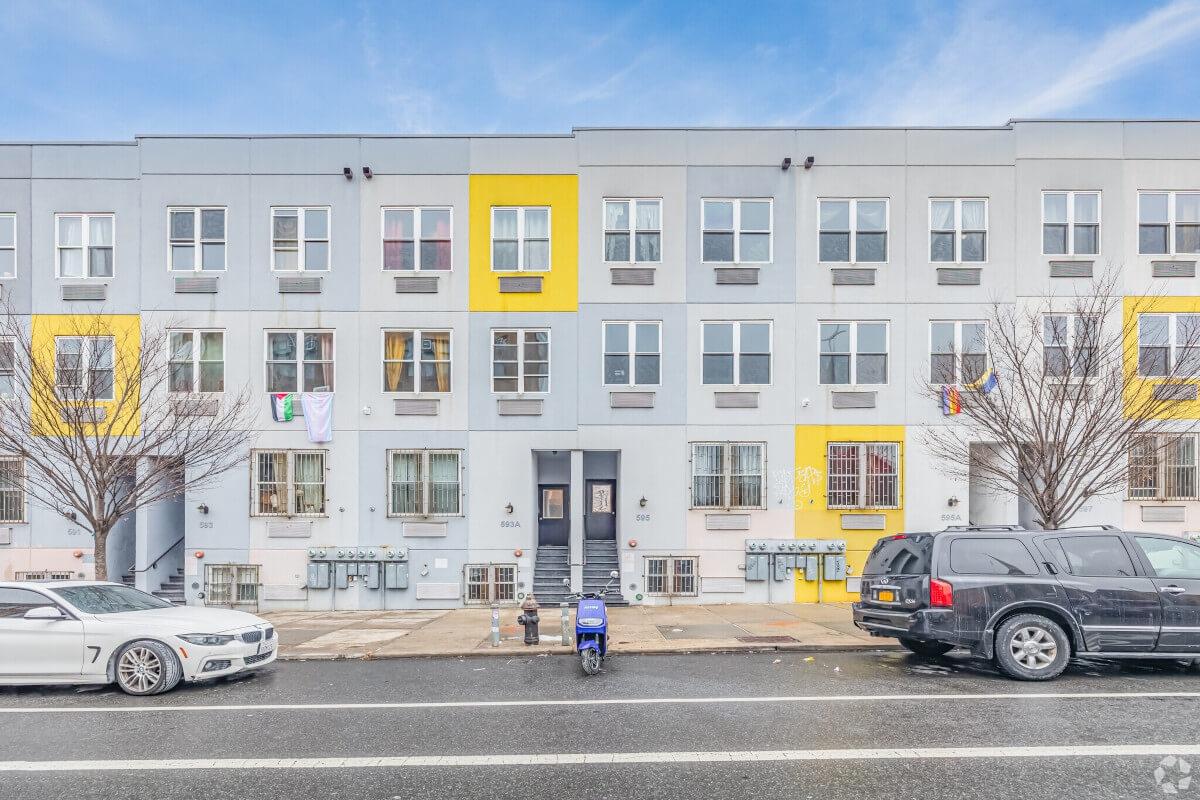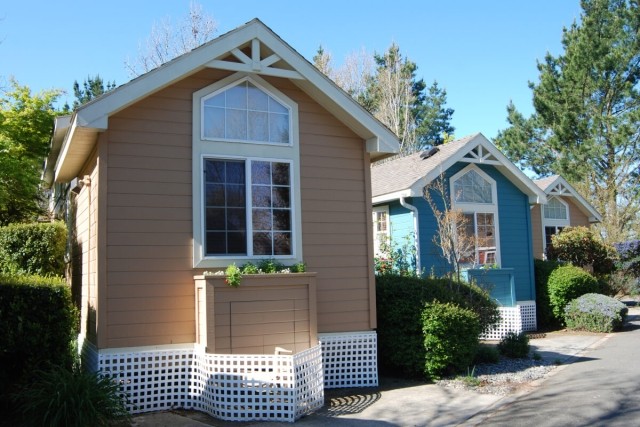When you hear the term “co-living,” you might picture a household of roommates or family members. Though these are common examples of communal living, “co-living” goes beyond these traditional arrangements. This relatively new industry trend redefines what it means to share a living space and is quickly gaining traction among renters.
So, what exactly is co-living housing then? And why is it trending? In this article, we’ll explore the concept of co-living housing and learn why it’s becoming popular among renters. Here’s a look at what we’ll cover:
- What is co-living?
- Why is co-living becoming popular?
- What are the advantages of co-living?
- What are the disadvantages of co-living?
- How do you find a co-living space?

What Is Co-Living?
Co-living is a type of shared housing arrangement in which a community of occupants lives together in a shared residence with both communal living spaces and private living quarters. The average co-living residence has at least five residents, each with their own separate lease. So, while Resident A might be living in the home for a year, Resident B might only be signed on for six months. This provides flexibility for each occupant and creates a growing, ever-changing living community.
Co-living spaces can come in all different forms. In certain markets, you might find co-living spaces in high-rise buildings with renovated, dorm-style lodging. While in others, co-living might take place in spacious, single-family homes. Generally, a co-living residence will include various amenities like common areas for socializing, coworking spaces, dining areas, cleaning/laundry rooms, and more. These areas are shared amongst every resident in the co-living space.
When it comes to bedrooms, certain co-living spaces offer more privacy than others. Some residences offer private living quarters for occupants. However, others might have a more dormitory style of living where multiple residents share a bedroom. The same goes for bathrooms, as you’ll find a mix of communal and private bathrooms, depending on the co-living space.
Why Is Co-Living Becoming More Popular?
Critics may call co-living a glorified college dorm for adults. However, they’d be surprised to know that more and more people are hopping on the co-living trend. Whether they’re looking to save money on rent or simply make some new friends, here are some reasons why co-living is becoming popular among U.S. renters:
Rising housing costs
In today’s housing landscape, everything seems to be getting pricier and pricier. According to data from Apartments.com, rent prices are expected to rise about 3.5% by the end of 2025. This trajectory is one of the main drivers for co-living demand. With rents increasing, many young renters can no longer afford to live alone. So, instead, they choose to co-live and split costs with other residents.
Changing lifestyles and preferences
Renters’ lifestyle preferences are changing, and space is no longer at the top of their wish lists. Instead, renters, particularly young professionals or students, prioritize location, amenities, and environment over square footage. Rather than putting rent toward a spacious home outside the city, modern renters prefer a more affordable, shared space in an urban area. This sets them up for an opportunity-full, explorative lifestyle where they can grow their careers and community connections.
Desire for community
Lifestyle changes lead us to the topic of community and socialization. Many young renters, particularly those who are early on in their careers or moving to a new city, seek opportunities for socialization and connection. Even if they can afford to live on their own, they might opt for a co-living space to expand their social circle. Living with a roommate or two can’t compare to the sense of community that comes with a co-living environment.

What Are the Advantages of Co-Living?
Whether you’re a social butterfly or just a renter on a budget, co-living housing has various advantages that can cater to your wants and needs, including:
Cost savings
Earlier, we touched on how co-living spaces are an affordable alternative to traditional rental properties. Rather than paying for rent and utilities on your own or with a few roommates, co-living spaces can cut your costs in half while still offering sought-after features like amenities and urban access. All you’ll be financially responsible for are your personal expenses and rent.
Built-in community
Living in a co-living space means having a built-in community. In a traditional living arrangement, you may have to put in more effort to get out of the house and socialize. With a co-living space, this hurdle will no longer be in your way, and you can build a social circle without having to leave the comfort of your home.
Convenience and ease
Co-living also brings a lot of convenience and flexibility. If you don’t have the time or energy to wash the dishes, you can rely on other residents to do the job. Or, again, if you don’t want to commute to see friends, you can instead get together with other tenants in a communal living space. Plus, with the option of short-term and month-to-month leases, you’ll have the flexibility to move out whenever you please.
Are There Downsides to Co-Living?
There’s no such thing as a perfect living arrangement, and co-living is no exception. While there are many benefits to co-living spaces, there are also several drawbacks that might deter you from choosing this lifestyle, including:
Lack of privacy
If you’ve ever lived in a traditional college dorm, you know how it feels to lack privacy. And unfortunately, co-living might bring about similar struggles. Lack of privacy is one of the biggest disadvantages to co-living housing, as sharing spaces with several housemates means minimal alone time. Even if you have a private bedroom to retreat to, you might still lack personal space in other areas of the residence.
Potential conflict with tenants
Another potential downfall of co-living is conflict with other tenants. When you get a group of five or more strangers together, people are bound to butt heads at some point. Whether someone hogs the laundry room or eats others’ food without permission, tension can arise when sharing living spaces and resources. Before you commit to co-living, make sure you have strong conflict-resolution skills in case any issues do arise.
Limited control and personalization
If you’re someone who likes to decorate and make a space your own, co-living might not be the best fit. Typically, co-living spaces are fully furnished, leaving little room for personalization. Considering the fact that you’re living with strangers, it may be strange to put up personal photos or items in communal spaces. However, you may be able to add some personal touches to your private living quarters if your residence has them.

How Do I Find a Co-Living Space?
If you’re sold on the idea of co-living, your next question might be, “How do I find a co-living space?” If you live in a dense, urban area, it should be fairly easy to find a co-living residence. However, this likely won’t be the case for renters in suburban or rural regions. Because the cost of living is typically higher in metro areas, there’s more demand for affordable co-living alternatives. However, more sprawling areas tend to be less expensive, which explains why the co-living trend has yet to take off.
If you live somewhere with co-living housing options, you can start your search on an online rental platform. When searching, make sure to keep amenities, communal living spaces, and lease options on your radar. As you would with any living arrangement, don’t rush into anything without vetting the residence first.
If you’re not entirely sold on co-living but are still interested in a communal renting experience, consider finding a room for rent on Apartments.com. Using our advanced search filters, you can filter your results to show available rooms for rent in your area. Rather than diving headfirst into co-living, renting a room will allow you to dip your toe in communal living. Then, if you decide it’s right for you, you can start searching for a full-fledged co-living space.
FAQs
Is co-living an affordable housing option?
Yes, co-living is often an affordable housing option, especially in cities with high living costs. By sharing spaces like kitchens and living rooms, residents can save on rent and utilities while still enjoying private bedrooms.
What are the pros of co-living?
Co-living offers affordability, convenience, and a built-in sense of community. It’s great for those who want to meet new people and enjoy flexible lease terms.
What are the cons of co-living?
Privacy can be limited since you share common spaces with others. Additionally, conflicts can arise over shared responsibilities, and the lack of personal space may not suit everyone.
Where is co-living most popular?
Co-living is most popular in urban areas with high housing costs, such as New York or Washington, D.C. Many cities are paving the way for office-to-residential conversions to co-living housing.






